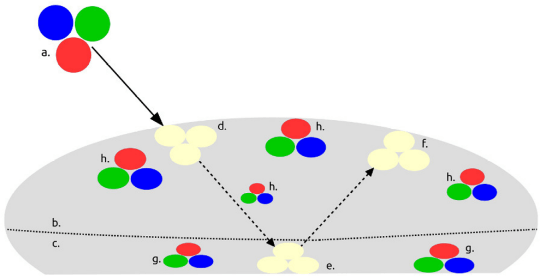
Dr. Michelle R. Stem has discovered an exceptional material that demonstrates three-dimensional (3-D) control over visible light photons!
Coherent poly propagation (CPP) is the newly identified property that displays 3-D visible light photonic control. CPP is exhibited by rare, non-crystalline silicates that are unusual specimens of precious opal that were mined from the ground, not made in a laboratory. This surprising material and its properties were identified and analyzed by Dr. Michelle R. Stem. Her research was published in the peer-reviewed journal, PLOS ONE, on October 17, 2019, at https://doi.org/10.1371/journal.pone.0223715.
The CPP property is different from the iconic play-of-color that is typical of precious opal. CPP causes a specimen to exhibit a special 3-D diffraction when exposed to many types of incident visible light (mono and polychromatic photon sources) in a manner that provides varying levels and types of control for the user. CPP diffracted light results in the propagation of multiple copies of the shape of an incident light source over the visible light spectrum. A user manually moves the specimens under an incident light to cause the propagated CPP diffraction shapes to visibly glide over the proximal (top) and/or distal (underside) surfaces of a 3-D specimen.
Additionally, manual movement can cause changes in the chromaticity of the propagated CPP shapes. CPP materials sometimes propagate light source shapes in the wavelengths of the incident light. Even more surprising, the CPP materials sometimes propagate light source shapes in upconverted and/or downconverted wavelengths over the visible spectrum. CPP materials allow angle of projection and chromaticity control.
Since opal is an amorphous silica material, its internal structure is assumed to be too random to exert any symmetry property on light. However, the CPP material displays an additional, unexpected, previously unknown photonic axial symmetry property. In short, as incident light traverses through a specimen, the light is rotated axially by the material. This material may lead to photon-based computational (yes/no or one/zero) signals based on the orientation of the propagated image instead of current electronic/magnetic methods.
The CPP and rotational properties of this material occur at ambient conditions (room temperature and ground-level atmosphere pressure). Furthermore, the material displays these exciting properties without the addition of exogenous (external) thermal, electrical, and photonic (other than the incident light) energies. Importantly, this extraordinary material is environmentally friendly because its highly abundant silica composition does not use, incorporate, or emit alpha or beta radiation or any other toxic or dangerous elements.
The CPP and axial symmetry properties have potential applications in many fields, such as security, communications, cryptography, imaging, projections, defense, computers, photonic waveguides, 3-D photonic control, microscopy, fiber optics, photonic wavelength demultiplexing, and more. Some of the specific potential applications include: multiple simultaneous wavelength transmissions (simulpathing) of tamper sensitive data, non-repudiation through selective wavelength masking and water-marking of transmissions by adding or deleting specific wavelengths, creation of real-time false ghost projections of assets (e.g. military planes in-flight, drones, ground-based items), the simultaneous calculation/verification of data in a multi-optical processor environment, real-time simultaneous imaging over multiple wavelengths without the time-delay and vulnerability of current image processing, photonic demultiplexing, multi-cast capable fiber switches and routers to bypass the current photon/electron/photon conversion steps and enable rotational shifting of transmitted fiber optic data with wavelength alteration.

Graphical depiction of CPP and PPOI with axial rotation. a. incident light, b. proximal side, c. distal side, d. incident PPOI, e. rotated transmitted PPOI, f. rotated reflected PPOI, g. rotated transmitted CPP, h. rotated reflected CPP. Dotted lines depict photon flow and demarcation between proximal (top) and distal (underside) sides. Image republished with permission from PLOS from https://journals.plos.org/plosone/article?id=10.1371/journal.pone.0223715
Dr. Stem’s research demonstrates that photons can be controlled over three dimensions in silicate materials by altering the chromaticity of incident light and changing the angle of the material, relative to the viewer and the light source. The discovery of this impressive material and its properties encompass a big step towards exceeding some of the current electron-based limitations (slower and larger, relative to photons). Additionally, the photonic control afforded by this material reverses typical assumptions that non-crystalline silicates like opal lack the ability to affect photonic behavior over a macroscopic space. Future research will refine materials to improve the display of CPP and axial rotation properties for implementation in 3-D photonic control in devices.









